Wear prevention
Degreasing the hull and the deck
In port, a boat is attacked by atmospheric pollution but also by oils. Not all marine engines are well adjusted and some cold starts result in a cloud of smoke, which is then deposited onto other boat’s hulls. To clean greasy deposits, we must begin by washing with plenty of water to remove any non-encrusted particles. The second step is the removal of fats with a suitable degreaser. Those that we offer do not tarnish the paint, gelcoat or attack stainless steel or Plexiglas. The only precautions one must take are to follow use instructions, permit the product to act for the specified time and wash well with water.
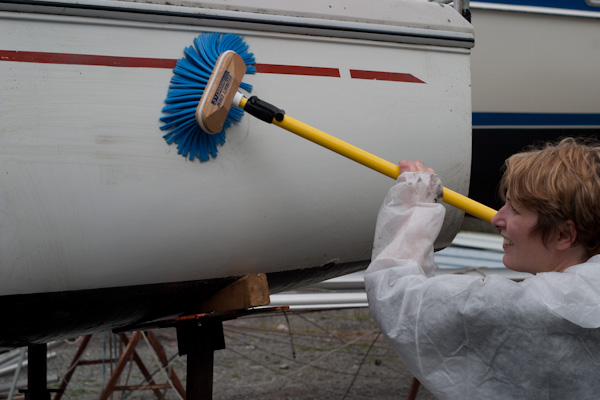
Shampoos
To minimize the annual work, it is advisable to maintain the hull regularly. To do this one opts for gentle shampoos that may be diluted in water (fresh or salt.) There are also protective wax cleaners. They prevent dirt adhering too rapidly. Caution; for these steps we must avoid using silicon based products. The silicone prohibits any future paint or gelcoat repair (products do not stick.)
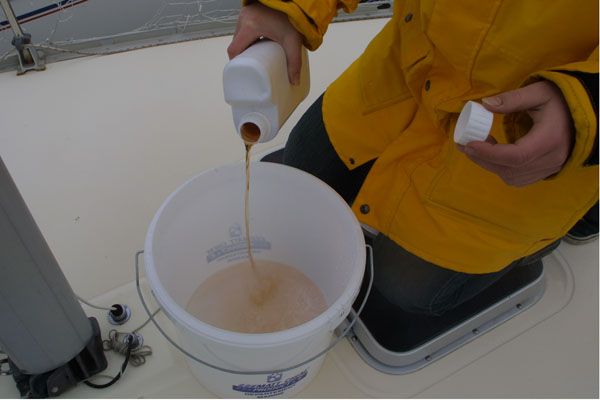
Yellowing around the waterline
The area directly above the waterline is particularly susceptible to yellowing. It is principally water (sea or river,) sun, algae and pollution. To clean this area you have to wash, degrease and apply an anti-yellowing product. The proposed products are biodegradable and packaged in gel form (to prevent them sliding over the hull.) After degreasing apply the gel, give it time to work, then rinse the treated area. We advise you to do this when the boat is dry.
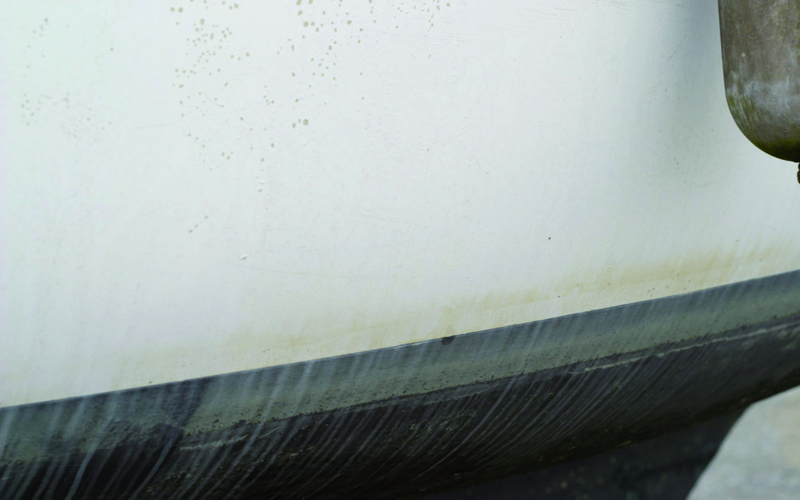
Hull polish
Due to aging, the gelcoat may become dull, porous and collect white deposits from hands being left on it (after 5 to 10 years depending on the quality of the gelcoat. In order to restore its original appearance, the solution is polishing. The polish will soften the appearance and restore the gloss to the gelcoat. To do this it is advisable to bring the boat ashore and use suitable products and equipment (orbital polisher, felt, buffers.)The polish has a kind of micro sanding process which restores a new appearance to the gelcoat. Certain creams also remove micro scratches. Once a smooth hull, with no scratches is achieved a reviving product may be used (made of titanium, PTFE or aqueous phase.) This renovator protects the gelcoat and prevents the adhesion of dirt. Before considering a re-paint of the hull, tricky, expensive and with an uncertain result, we advise you to first polish your hull. You will be surprised with the result. This is particularly striking with colourful shells.
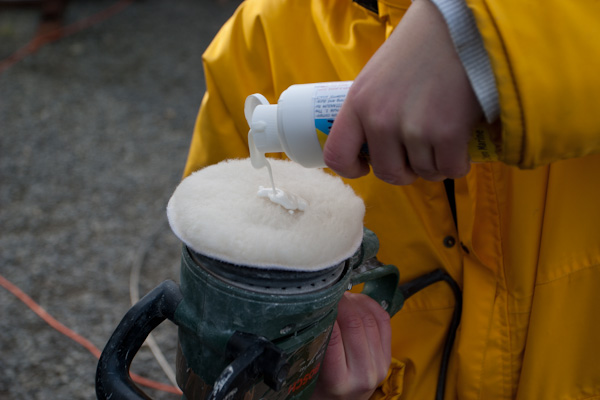
Une lustreuse équipée de bonnette reste l'outil indispensable pour polir de grandes surfaces.
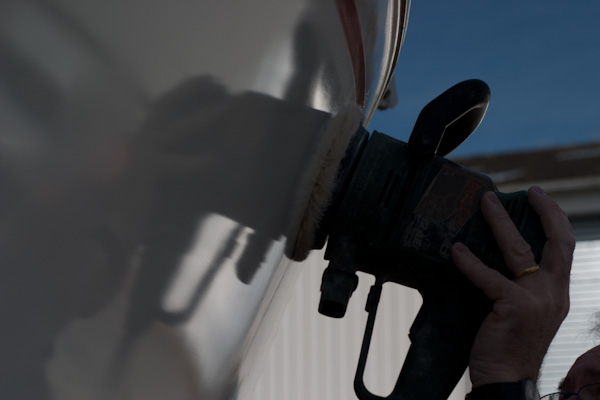
Stainless steel
A good stainless steel rusts! In principle stainless steel is an alloy which does not contain iron so should not rust. However, without iron, stainless steel becomes brittle. A solid stainless steel therefore, contains small amounts of iron and will rust eventually. Additionally, with time, all sorts of deposits settle on it, leading to pitting rust (e.g. the use of metal oxide tools on a section of stainless steel.) These pits are superficial but, for aesthetic reasons, there are products to remove them and passivate the steel. The products are generally pastes which are applied to the stainless steel and work in two phases. During the first phase one lets them act on the product (for about 5 minutes.) The second phase involves the rubbing of the product with a soft cloth, to polish. Most of the products selected by AD passivate the stainless steel in order to prevent the rapid formation of rust on the treated areas.
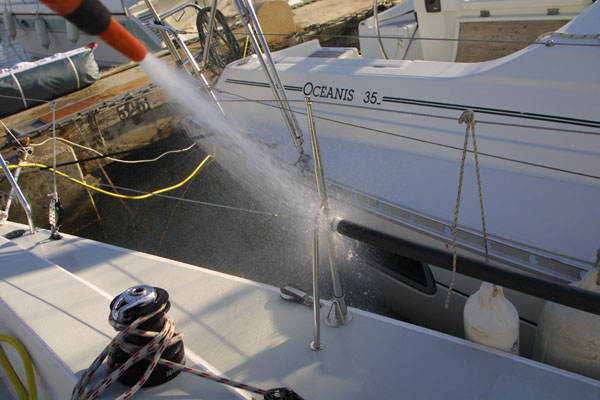
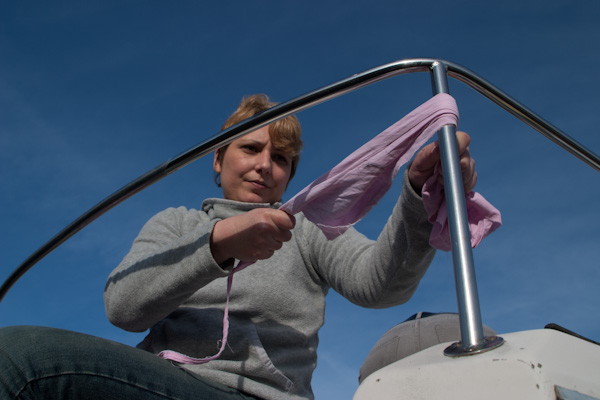
Cleaning and maintaining the teak decking is a necessity. Indeed, teak is a tropical wood that will withstand the elements, sea water, salt air and accidental staining…but will also absorb water, deform, crack and dry out if not cared for. Teak is a wood consisting of tough fibres, surrounding oily supple fibres. This is why it should not be rubbed with a hard brush and also in the direction of the fibres. The brush is likely to damage the soft teak fibres. To restore teak you should proceed in three steps;
-Clean with a soft brush, with a product that removes the grey, grease stains and oils.
-Revive with a flexible spreading brush and a product that restores the natural teak colour.
-Feed with a teak oil. There are a number of products depending on whether one wishes to lightly stain the teak or retain the original colour.
-Clean with a soft brush, with a product that removes the grey, grease stains and oils.
-Revive with a flexible spreading brush and a product that restores the natural teak colour.
-Feed with a teak oil. There are a number of products depending on whether one wishes to lightly stain the teak or retain the original colour.
Tips
Read the manufacturers information well, dilute if necessary, with the volumes indicated and above all follow the application times. You will be plesantly surprised
Ecology
True in word and deed
AD does not follow the current fashion, exclusively marketing and advertising based on misleading words such as, “100% Ecological,” “100% organic,” “100% green,” or, “100% natural.” We provide only essential information, which is needed to judge both products and their environmental effect. For example, the indication 100% biodegradable never states whether the statement is 100% of the entire form of the products or just the surfactants contained therein. It is necessary to know that the raw materials used in the making of certain products, “eco-labelled,” may be of petroleum origin. In contrast, surfactants of vegetable origin products may have been chemically altered. The 100% natural misleads the consumer. Finally, it is important to know that even vegetable extracts may be as toxic to flora and fauna, as the synthetic kind. Be aware that not every plant may be used in its natural form. It is often necessary to extract, modify or separate molecules by chemical or
biochemical action.
AD does not follow the current fashion, exclusively marketing and advertising based on misleading words such as, “100% Ecological,” “100% organic,” “100% green,” or, “100% natural.” We provide only essential information, which is needed to judge both products and their environmental effect. For example, the indication 100% biodegradable never states whether the statement is 100% of the entire form of the products or just the surfactants contained therein. It is necessary to know that the raw materials used in the making of certain products, “eco-labelled,” may be of petroleum origin. In contrast, surfactants of vegetable origin products may have been chemically altered. The 100% natural misleads the consumer. Finally, it is important to know that even vegetable extracts may be as toxic to flora and fauna, as the synthetic kind. Be aware that not every plant may be used in its natural form. It is often necessary to extract, modify or separate molecules by chemical or
biochemical action.
C'est très bien de nettoyer sa cale avec un produit respectueux de l'environnement. Encore faut-il ne pas rejeter ses eaux grasses à la mer. Pour cela, utilisez des absorbeurs d'hydrocarbure.
What is a surfactant?
To identify issues of biodegradability of detergents, it is necessary to explain what surfactants, or surface agents are. In effect a detergent is composed of surfactants and a great deal of water. So why are they important! A surfactant is capable of wetting, emulsifying, solubilizing and foaming. It lowers the surface tension of water. Soaps are the best known surfactants. They are obtained by mixing a fatty substance which may be vegetable (olive oil,) animal (tallow,) or mineral with a basic substance (sodium, potassium ...) They are generally used for washing clothes, dishes ... Then there are synthesized surfactants, mostly made from oil. They are produced by conversion of compounds by sulfation or sulfonation ... Finally, there are surfactants produced from the plant world. These include oilseeds such as coconut oil, palm kernel oil, rapeseed oil…or compounds from proteins and sugars extracted from grains for example. One finds all these varieties available on the market. AD has chosen to look primarily at surfactants of vegetable origin and select
detergents from easily renewable components. Their natural origin and ability to provide better biodegradabiliyt ensures their compatibility with the marine enviroment.
detergents from easily renewable components. Their natural origin and ability to provide better biodegradabiliyt ensures their compatibility with the marine enviroment.
